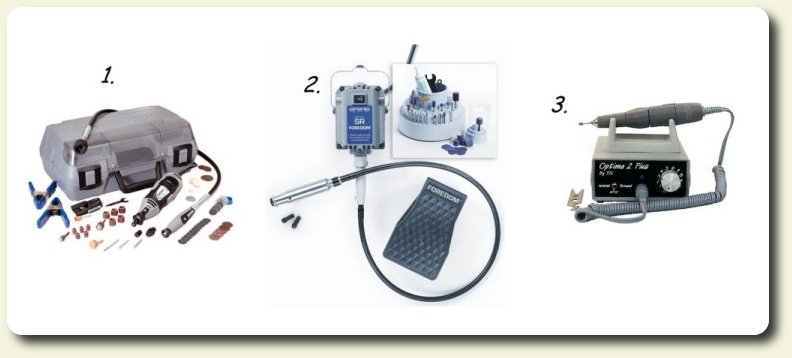



Just Don't Take Your Dad's!
John Allard
Staff Writer
"I love tools!"
There I said it. All my life I have had a love affair with tools, much to the chagrin of my father who was forever looking for this missing tool or that one. Or cherished possessions. From taking apart his harmonica to one of his beloved clocks, to... well, you get the picture, tools allowed me to explore my creativity and my curiosity.
Now, many decades later as an artist and inventor, tools are an inextricable part of my life and there is one primary rule I live by: "Use the right tool for the job." So for this column I would like to talk about probably the most versatile tool on the market today for all of us crafty folks and that tool is the rotary power tool, or as most of us have come to know them, the Dremel tool! (Figure 1).
Now I know there are many out there thinking to themselves "oh yes I've seen those but they seem dangerous, or very difficult, and very complicated." Well I am here to tell you that there is nothing further from the truth. For the miniaturist the rotary power tool is the King of All Tools, capable of doing so many jobs from drilling, to sanding, to cutting, shaping, carving and so many more things that it boggles the mind. A rotary power tool is quite simply a motor attached to a revolving shaft, with a chuck at the end for holding metal bits. A "bit" can be a drill, a sanding drum, a buffing wheel, a cutting head, a cut-off disc, etc. A quick trip to the local hardware store or home center tool section will show you but a sampling of what they have to offer.
As well as the aforementioned Dremel, which comes in a stick configuration (much like a power screwdriver, figure 2), there are also flexible shaft styles made popular by Foredom tools, in which the motor hangs from a support and a flexible shaft extends down to a pencil style handle. This style is very popular with professional and amateur wood carvers, as they are very powerful and with the hand piece very easy to manipulate. The last (and my favorite) is the micro motor which uses a tabletop power supply with a built-in rheostat to control the speed and a coiled cord attached to a pencil-style handpiece that contains the motor. These are perfect for the delicate work of the miniaturist, but come with a price tag that is quite a bit heftier than the common Dremel tool.
The micro motor (figure 3 above) is also slightly less powerful than the others being designed primarily for jewelers. I love them because of the comfort of use and the extreme control of speed with a quick release chuck built into the handle. The lack of powerful strength is a non-issue for the artistic tasks I need it for.
With such a range of attachments and bits, a rotary power tool can speed up your work, simplify it and give you the professional results you seek. Imagine a micro circular saw to cut wood or plastic, a drill to quickly and cleanly make holes, a carving bit to shape a sculpture or part, or even to re-shape a part to meet your needs, or to clean up the seams of a porcelain doll. They work with soft metals, wood, plastic, Sculpey, bone, glass and much, much, more. If you are looking for a tool that can change the way you do miniature work, I suggest strongly that you look into a rotary power tool.
Until next time, go out and make something!
Custom Dolls, Houses & Miniatures / CDHM







